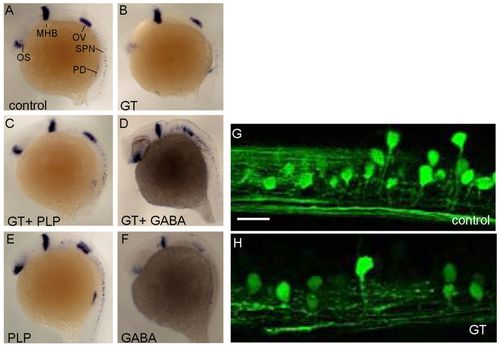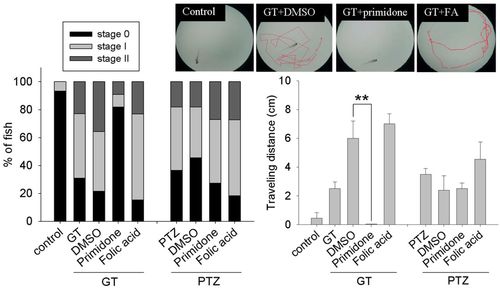- Title
-
Zebrafish larvae exposed to ginkgotoxin exhibit seizure-like behavior that is relieved by pyridoxal-5'-phosphate, GABA and anti-epileptic drugs
- Authors
- Lee, G.H., Sung, S.Y., Chang, W.N., Kao, T.T., Tu, H.C., Hsiao, T.H., Safo, M.K., and Fu, T.F.
- Source
- Full text @ Dis. Model. Mech.

ZFIN is incorporating published figure images and captions as part of an ongoing project. Figures from some publications have not yet been curated, or are not available for display because of copyright restrictions. PHENOTYPE:
|
|
Quantitative analysis of behavioral seizures induced by ginkgotoxin exposure and of response to AEDs. Embryos at indicated stages (3 dpf, 5 dpf or 6 hpf) were co-treated with both ginkgotoxin (GT) and anti-convulsing compounds simultaneously for the indicated time duration before video-recording (subgroup 2). (A) Sample locomotion tracking of 1.5 minutes are shown for individual larva at the end of treatment. (B) The traveling distance and velocity of larval displacement were analyzed. At least ten larvae were recorded for each group. Bars show mean + s.e.m. **P<0.0001. PHENOTYPE:
|

ZFIN is incorporating published figure images and captions as part of an ongoing project. Figures from some publications have not yet been curated, or are not available for display because of copyright restrictions. PHENOTYPE:
|
|
Ginkgotoxin does not affect the development and appearance of zebrafish larvae. Zebrafish embryos were raised in fish water (control) or water containing 0.5 mM ginkgotoxin (GT) from 6 hpf to 72 hpf. (A–D) The lateral (A,C) and dorsal (B,D) views of embryos revealed no observable morphological differences in larval size and appearance between control and ginkgotoxin-treated groups. (E–H) The H&E-stained transverse cryosections of larval head regions and anterior trunk are oriented dorsal (top) to ventral (bottom) (E, F). Histochemical examination of the myotomes and notochord of embryos revealed no obvious difference between the control and ginkgotoxin-treated groups despite the variation in their shape (G,H). (I–P) The development of embryos were characterized at 24 hpf with in-situ hybridization using probes specific for somatic muscle (myo D, caudal lateral trunk views), rhombomere (krox20, lateral view with anterior to the left) and glutamatergic neurons (vglut2.1 and vglut2.2, dorsal view). (Q,R) The posterior lateral line formation was characterized at 72 hpf by staining with DASPEI. m, myotome; n, notochord; e, eyes; d, diencephalon; t, tectum; s, somite; r3, rhombomere 3; r5, rhombomere 5. PHENOTYPE:
|
|
Ginkgotoxin-induced malformation of optic stalk and spinal cord neuron was partially reversed by PLP or GABA supplementation. Zebrafish embryos were raised in fish water (control) or water containing 500 μM ginkgotoxin added at 6 hpf (GT). (A,B) The development of embryos were characterized at 24 hpf using in-situ hybridization with pax2.1 probe (lateral view with anterior to the left). Development of ostic stalk and spinal cord neuron were interfered with in the ginkgotoxin-treated group (B) and the effect was reversed in the presence of 0.5 mM PLP (C) or 0.5 mM GABA (D). Adding PLP alone did not cause observable changes in embryos (E), whereas adding GABA alone to the water impeded the development of pax2.1-expressing tissues, especially optic stalk, otic vesicle and spinal cord neuron (F). (G,H) Confocal microscopy images of the nortochord in the trunk of Tg(alx:GFP) transgenic embryos at 3 dpf. OS, optic stalk; MHB, midbrain-hindbrain boundary; OV, otic vesicle; SPN, spinal cord neurons; PD, pronephric duct. Scale bar: 8 μm. EXPRESSION / LABELING:
PHENOTYPE:
|
|
Primidone relieved the larval seizure-like behavior induced by ginkgotoxin exposure but not by PTZ treatment. Zebrafish larvae at 3 dpf were incubated in water containing convulsing agents with or without the presence of primidone for 2 hours before video recording and analyzed for the stage distribution (left) and total distance of larval displacement (right). The larval behavior was categorized into three stages on the basis of the characteristics of their swimming patterns: stage 0, no or low swimming activity; stage I, mildly increased swimming activity; stage II, whole body convulsion, erupting swimming and misshaped. There were at least ten larvae included for each group. Bars show mean + s.e.m. **P<0.0001. PHENOTYPE:
|




